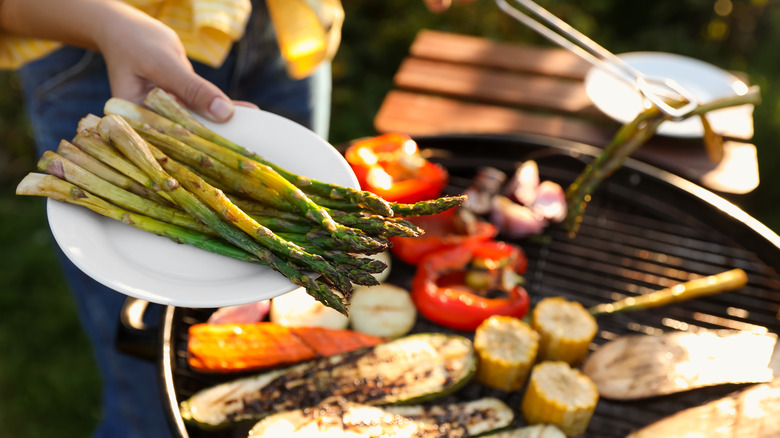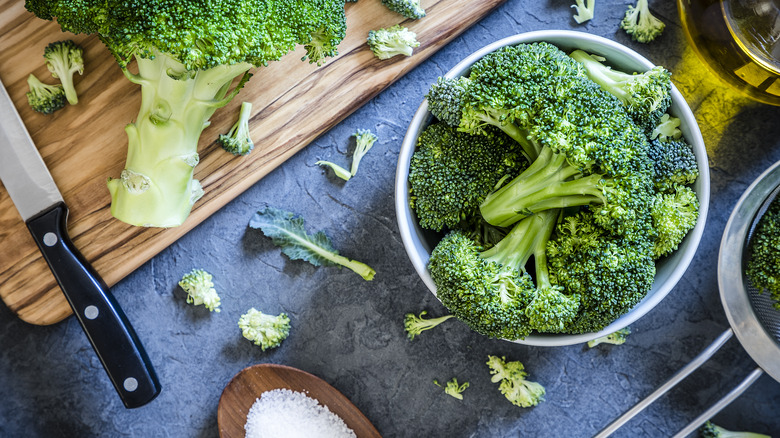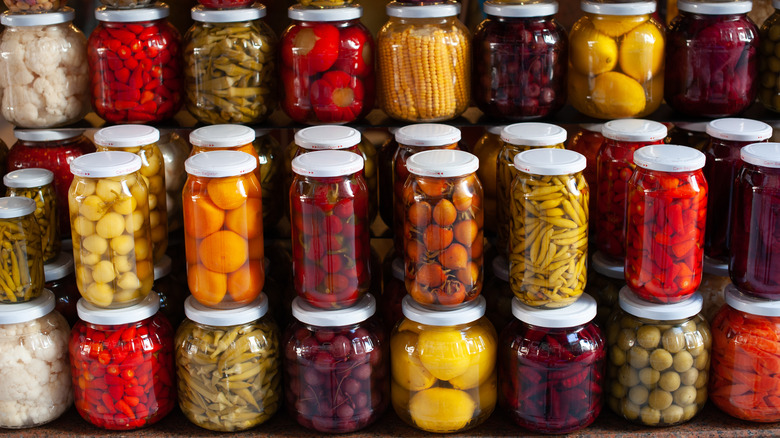Make Pickled Veggies Substantially Better With A Quick Trip To The Grill
Is there a happier feeling than finding pickles in your fridge when you're hungry and searching for a snack? Pickled veggies are truly versatile: They can be eaten right out of the jar, added to a deli burger or a cheeseburger dip, and even used as a pizza topping. Although preserved vegetables are already mouthwatering when done traditionally, there's a way to make them even better — firing up the grill before pickling them. The idea was popularized by American food journalist and author Mark Bittman, who covers the technique in his book "How to Grill Everything."
Bittman told Epicurious that grilling the vegetables before pickling will evaporate their moisture, boosting their bite and lending them a savory depth. The vegetables will have a smoky taste, and when you add them to a brine, your only source of flavor won't just be the pickling liquid. According to the noted food writer, escabèche and giardiniera, which require the vegetables to be marinated after cooking, are dishes he will "make frequently." They're also apparently how he first thought to grill before pickling. Once you try adding some fire to your favorite ferments, you may never go back to pickling the old way.
Which vegetables to use and how to prepare them
Grilled pickles can be made with either vegetables or fruit, but you should choose things that won't turn soft after spending time over the flames. If they're too wilted, they'll lose their form when added to the brine. This can happen with a few gourds, like spaghetti squash, although other varieties, such as butternut squash and zucchini, will work well.
The way the ingredients are prepared for both the grilling and brining processes may affect how the pickles turn out, impacting their crunch. The size of the produce is another potential issue. Cucumbers and carrots can be prepared whole, cut in halves, or quartered. Cruciferous vegetables like broccoli and cauliflower work best as florets. Asparagus and radishes only need to have their ends trimmed. However, to make some radish varieties bite-sized, cutting them in half might be a good idea. Zucchini can be cut into spears, thick round slices, or in the form of matchsticks. Fennel can be cut in half for grilling, but for pickling, it should be cut into matchsticks so that it fits into a jar and is easier to eat.
Tips for grilling and brining vegetables
The cut produce can be added directly to the grill, though a perforated grill pan will come in handy if the pieces are too small. The goal is for the vegetables to become deeply browned or even charred on all sides without turning soft, but this can be achieved by turning them often. The grilling process may take up to 15 minutes, however, this depends on each vegetable, how they're cut (or not), and how hot the grill is.
Conveniently, you can use pretty much any quick pickle brine, even the base for quick pickled garlic jalapeños (you can even char and pair the peppers with your other vegetables). Make sure to let the liquid cool; pouring the hot brine over the already grilled veggies might cook them even more, turning them soft. You can brine the vegetables in a plastic, glass, or metal bowl – just make sure to cover it tightly and check on the progress often, giving everything a stir when you do.
This is a great quick pickling method that yields a unique tangy end product; it's made even better by the fact that the pickled veggies are ready to eat on the same day they're prepared — something that doesn't always happen with conventional pickles, which usually call for the veggies to ferment for days and sometimes weeks. Meanwhile, the grilled pickles can be stored in an airtight container for up to a week in the fridge.


